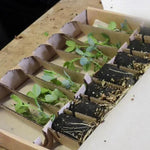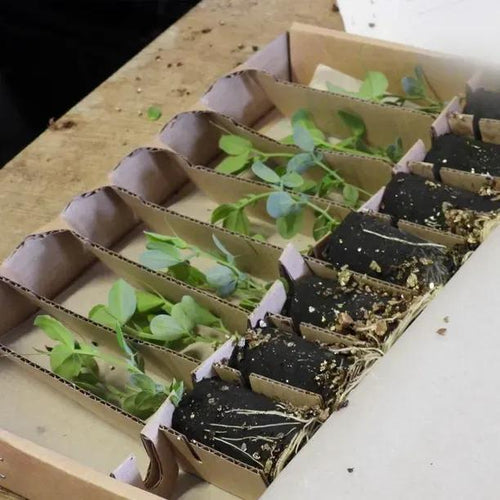Bristol Sweet Pea Plants
Bristol sweet pea is a favourite of both exhibition growers and amateur gardeners alike, as its many awards will attest. Its pale blue/cream flowers, reaching 4cm across, are gently shaded. See our full range of sweet peas.
Our Sweet Peas are delivered in purpose-designed, recycled cardboard packaging, and are ready to be planted out when you get them.
We generally send them out between March and May, but we will email you with the likely delivery timescale once you have placed your order.
It has a heady, strong fragrance - one of the best - and the strong, long-stemmed, frilly Spencer-type blooms make Bristol perfect as a cut flower.
The flowers open as a uniform soft blue. The standards open flat with a cream rim, becoming strongly waved, soft blue slightly paler at the edges, wings soft blue, even paler at the edges. This gentle shading shows off each petal to best effect and the florets are well-placed on the stem, making it a favourite with exhibitors and florists. The National Sweet Pea Society classes it as a Pale Blue.
Garden Design Ideas
The exceptional pale shading and perfume of Bristol mean it's best used near the front of a border on its own on an obelisk or on a trellis, so it can be appreciated fully. However, dark glossy evergreen leaves, such as Fatsia japonica will act as a wonderful backdrop, as will a black wall, creating a contemporary look.
Sweet pea Bristol is ideal for growing in large pots on a patio, where its beautiful perfume and delicate colouring can be appreciated next to a seating area. In fact, it's the ideal plant to grow over a pergola. Plants will need extra watering and a high potash plant food (such as tomato fertiliser) to keep flowering throughout the season. Don't forget to keep deadheading - if seed pods are allowed to develop, the sweet pea's flowering mechanism will switch off.
Features
- Colour: Shaded pale blue with cream edges
- Stem: Long and strong
- Height: 2m
- Type: Spencer
- Scent: Strong and heady
- Flowering: May-October
- Planting Months: March-June
- RHS Award of Garden Merit, AM
History & Trivia
Phil Kerton, from Somerset, bred it in the early 1990s. It has won the Award of Merit of Exhibition, the RHS Award of Garden Merit, the FC Harris Memorial Award (Best Seedling at RHS Wisley and RHS Harlow Carr Trials) and the Clay Cup for the best vase in the National Sweet Pea Society National Show.

 Secure, One-Tap Checkout
Secure, One-Tap Checkout
 Hand Picked, Delivered to Your Door!
Hand Picked, Delivered to Your Door! 1 Year Bareroot Guarantee
1 Year Bareroot Guarantee




